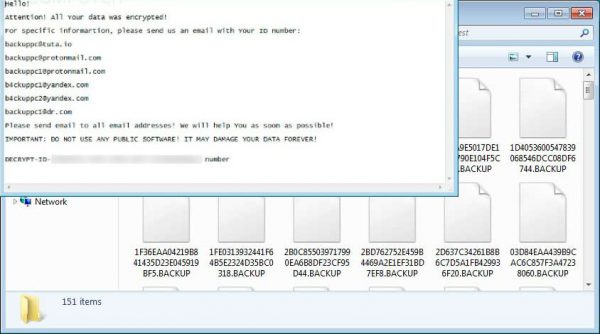.BACKUP extension, as added to the names of the files stored on a computer system indicates Cryptomix Trojan has compromised the system and completed its malicious payload. Its core action reworks files to be found on the attacked device with a military-grade scrambling method. This basically leaves no chance for any, even the most powerful computer of our age, to reverse the files affected to their original state.

Ultimate goal pursued by .BACKUP ransomware is to get money from the users of the computers it hits. The trick follows its due course as the infection drops its ransom note that notifies of the encryption completed and prompts one to pay for the decryption.
To that end, .BACKUP is a variant of Cryptomix ransomware. One of its distinct traits is the updated ransom note. The amendments chiefly relate to the new set of email addresses indicated. A victim is supposed to contact one, for instance, [email protected], for detailed instructions on the transaction to be completed.
The ransomware goes beyond encrypting file content and adding its. BACKUP extension as a hallmark. It also shuffles original filename so that it becomes gibberish.
To get installed on a computer system the ransomware resorts to a variety of tricks. It is available from its developers in a number of online hubs hosting more or less criminal affairs. Entry barriers are low enough so that roughly anyone can engage into the malicious business. However, masterminds of the scam remain anonymous not only to the victims; they keep their identity undisclosed for the mediators, too.
Meanwhile, most of the attacks deploy through mass-mailing. Be it a targeted spam or general circulation of the infection, the user may easily avoid the ransomware installation. It should only be a must to verify the content entering the machine, even if you believe the recipient is among your trusted acquaintances.
There is no ultimate decryption for the infection as of now. A mere removal of .BACKUP ransomware does not work magic to restore the files encrypted. However, paying the ransom is a tricky and unfair solution, both in terms of likely issues in receiving and applying the decryptor and providing further incentives to the scammers.
The guidance below enables ransom-free assistance in the recovery targeting the .BACKUP encryption-for-ransom.
Automatic removal of .BACKUP File Virus
The benefits of using the automatic security suite to get rid of this infection are obvious: it scans the entire system and detects all potential fragments of the virus, so you are a few mouse clicks away from a complete fix.
- Download and install recommended malware security suite
- Select Start Computer Scan feature and wait until the utility comes up with the scan report. Proceed by clicking on the Fix Threats button, which will trigger a thorough removal process to address all the malware issues compromising your computer and your privacy.
Restore files locked by .BACKUP File Virus
new Locky variant aka .BACKUP File Virus represents a unique category of malicious software whose attack surface reaches beyond the operating system and its components, which is why removing the virus itself is a part of the fix only. As it has been mentioned, it encrypts one’s personal information, so the next phase of the overall remediation presupposes reinstating the files that will otherwise remain inaccessible.
-
-
Launch data recovery software
Similarly to the rest of its fellow-infections, .BACKUP File Virus most likely follows an operational algorithm where it erases the original versions of the victim’s files and actually encrypts their copies. This peculiarity might make your day, because forensics-focused applications like Data Recovery Pro are capable of restoring the information that has been removed. As the virus further evolves, its modus operandi may be altered – in the meanwhile, go ahead and try this.
-
-
Take advantage of Volume Shadow Copy Service
This technique is based on using the native backup functionality that’s shipped with Windows operating system. Also referred to as Volume Snapshot Service (VSS), this feature makes regular backups of the user’s files and keeps their most recent versions as long as System Restore is on. .BACKUP File Virus ransomware hasn’t been found to affect these copies therefore the restoration vector in question is strongly recommended. The two sub-sections below highlight the automatic and manual workflow.
- a) Use Shadow Explorer Shadow Explorer is an applet that provides an easy way of retrieving previous versions of files and folders. Its pro’s include an intuitive interface where the computer’s entire file hierarchy is displayed within one window. Just pick the hard disk volume, select the object or directory to be restored, right-click on it and choose Export. Follow the app’s prompts to get the job done.

- b) Use file propertiesEssentially, what the above-mentioned Shadow Explorer tool does is it automates the process that can otherwise be performed manually via the Properties dialog for individual files. This particular approach is more cumbrous but just as effective as its software-based counterpart, so you can proceed by right-clicking on a specific file, which has been encrypted by .BACKUP File Virus, and selecting Properties in the context menu. The tab named Previous Versions is the next thing to click – it displays available versions of the file by date of the snapshot creation. Pick the latest copy and complete the retrieval by following the prompts.

-
Data backups work wonders
Ransomware like .BACKUP File Virus isn’t nearly as almighty and destructive in case you run regular file backups to the cloud or external data media. The virus itself can be completely removed in a matter of minutes, and the distorted information can then be just as easily recovered from the backup. Luckily, this is a growing trend, so ransom Trojans are hopefully going to become less subversive in the near future.
Verify thoroughness of the removal
Having carried out the instructions above, add a finishing touch to the security procedure by running an additional computer scan to check for residual malware activity
